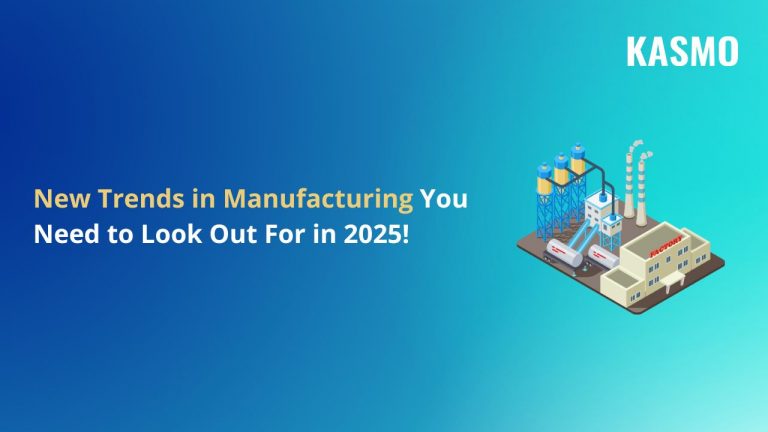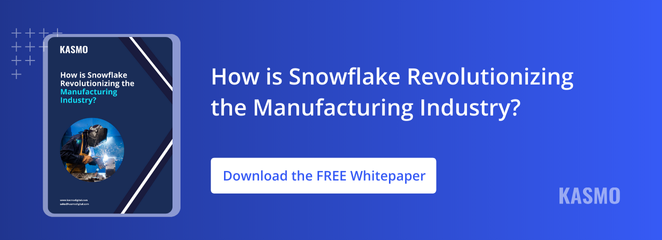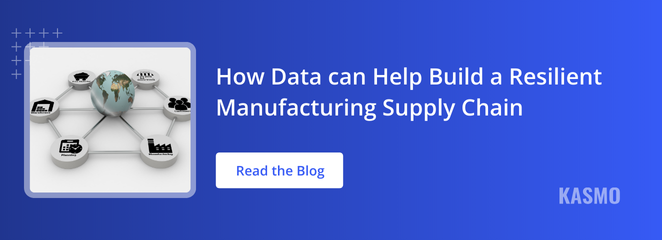With the beginning of 2025, new innovations have started to arrive in the manufacturing industry. With these new technologies, manufacturing companies are seeing a shift in consumer expectations. As we move further into 2025, the new trends in manufacturing like smart manufacturing, industry 4.0, automation, sustainability efforts, and the demand for data-driven insights have been a hot topic among business leaders. In this era of transformation, industry leaders must keep pace with these current trends in manufacturing to remain competitive and meet market demands.
Let’s explore these emerging trends and how they are reshaping the future of the industry:
Uncovering the Future of AI in Manufacturing
Artificial Intelligence (AI) has been a game-changer in the manufacturing industry. However, understanding where you can use AI to solve critical challenges in 2025 is crucial. AI-powered solutions can analyze vast amounts of data in real-time, enabling manufacturers to identify trends, predict maintenance needs, and optimize production lines. With machine learning algorithms, AI will help manufacturers identify inefficiencies in their processes, detect potential issues before they escalate, and fine-tune production schedules for maximum efficiency.
Snowflake – a leading cloud data platform provides a simplified and unified platform to build AI-powered tools and applications effortlessly without breaking your back over complex codes! With Snowflake you can improve your supply chain performance, implement smart manufacturing practices and collaborate effortlessly with your partners, suppliers and customers.
One of the most significant contributions of AI in the manufacturing industry is predictive maintenance. Rather than relying on scheduled checks, you can implement AI to analyze sensor data from machines and predict when maintenance is needed, reducing unexpected breakdowns and extending equipment lifespan. This leads to increased uptime, lowered operational costs, and improved product quality. Additionally, AI is empowering manufacturers to personalize production to meet customer demands more efficiently, making AI a critical player in improving manufacturing agility and scalability.
Digital Twins: Virtual Replicas for Smarter Manufacturing Decisions
In 2025, digital twins will play an even more central role in manufacturing trends. This technology involves creating virtual replicas of physical assets, processes, or entire production systems, allowing manufacturers to monitor, simulate, and optimize performance in real time. By using sensors and IoT devices to collect data, digital twins provide a dynamic, real-time view of production systems, highlighting inefficiencies and identifying opportunities for improvement before making changes, saving on overhead costs.
Manufacturers can use digital twins in complex manufacturing processes, like aerospace, automotive, and industrial equipment production, where precision and quality are crucial. With the ability to simulate various conditions, manufacturers can test different operational strategies, predict potential risks, and optimize workflows—all without disrupting ongoing production. Now manufacturers can drive operational efficiency and support innovation by enabling manufacturers to experiment in a virtual environment.
Automation and Robotics: Redefining Manufacturing Efficiency
One of the most popular and new trends in manufacturing are automation and robotics. The use of robotics and automation in manufacturing is huge as we move further into 2025. Automation, powered by robotics, is taking over repetitive and physically demanding tasks, from assembly to material handling, freeing human workers for more creative and strategic roles. This increased automation leads to faster production cycles, improved accuracy, and reduced human error.
According to Infosys, 68% of decision makers in the manufacturing industry are focusing on creating better resilience and agility. With automation and robotics, you can optimize your assembly lines and improve your overall manufacturing process. Additionally, robots can work around the clock, driving continuous production and enabling manufacturers to meet rising demand.
Furthermore, robotic systems integrated with IoT sensors and AI can detect anomalies, conduct routine maintenance tasks, and automatically adjust production parameters, creating a smarter, more adaptable manufacturing environment. As robotic capabilities continue to evolve, automation will remain at the core of improving your team’s efficiency and productivity.
3D Printing: Revolutionizing Design and Prototyping
One of the most exciting new trends in manufacturing for 2025 is the further development and application of 3D printing. This technology has already made waves in rapid prototyping, but manufacturers can utilize its potential in full-scale production. 3D printing also enables manufacturers to produce complex parts like intricate geometries that would be impossible or expensive using traditional methods.
For industries like aerospace, healthcare, and automotive, where customization and precision are critical, 3D printing allows manufacturers to create bespoke parts on-demand, reducing inventory costs and accelerating production timelines. Additionally, 3D printing significantly reduces waste and enhances sustainability practices of the organization. With 3D printing you can avoid wastage of materials and prevent materials from being deposited layer by layer. In the coming years, this will continue to be a critical trend for manufacturers aiming for both efficiency and sustainability.
Additionally, 3D printing enables rapid iteration during the design process, empowering manufacturers to test prototypes, adjust, and streamline product development. This technology is fast becoming a cornerstone of smart manufacturing, allowing companies to innovate without the high costs and delays caused due to traditional methods.
Practicing Sustainable Manufacturing
As environmental concerns become more pressing, sustainable manufacturing will be an integral focus in 2025. Today’s consumers demand transparency about the sustainability of the products they buy, including information about carbon footprints, sourcing materials, and labor practices. The future of manufacturing industry is greatly dependent on reducing waste, conserving energy, and minimizing environmental impact.
Manufacturers are increasingly adopting green technologies and sustainable practices, such as using renewable energy, reducing water consumption, and recycling materials. For instance, companies are shifting towards opting for materials and products that can be reused, refurbished, and recycled, reducing the need for new resources and mitigating environmental impact.
Globally, governments are also implementing stricter environmental regulations, pushing manufacturers to innovate and adopt more sustainable production processes. In 2025, manufacturers who invest in energy-efficient technologies, sustainable materials, and eco-friendly practices will meet regulatory requirements and stay at an advantage by appealing to environmentally conscious consumers.
Shifting to Service-Centric Business Models
Manufacturers are increasingly shifting from product-centric business models to service-based business models. These business models involve offering after-sales services such as maintenance, repair, and upgrades. This transformation in the manufacturing industry is driven by the desire to create long-term customer relationships and generate recurring revenue streams. By offering services that extend the life of products, manufacturers can differentiate themselves from their competitors.
By offering comprehensive service packages, manufacturers can ensure customer satisfaction and collect valuable data about product performance, which can inform future design improvements.
Creating a service-based business model also supports sustainability efforts, as manufacturers can extend the lifecycle of products, reduce waste, and optimize resource utilization. This shift in business models will continue to gain momentum in 2025 as manufacturers seek to provide more value to customers beyond just selling their products.
Bringing Manufacturing Back Home – What is It?
In response to global supply chain disruptions, geopolitical risks, and labor shortages, reshoring. What is reshoring? Manufacturers are bringing their business back to their home countries. Reshoring helps in elevating the local economy and allows manufacturers to use locally sourced materials, hire local labors and protect themselves from any sudden geopolitical unrest. This trend has gained a lot of traction since the COVID-19 pandemic, which disrupted several global supply chains. As inflation continues to climb, manufacturers face rising labor costs in overseas locations. Therefore, reshoring offers several strategic benefits.
By bringing production closer to home, manufacturers are also saving on transportation costs, improving quality control, and shortening market-to-product time. Reshoring also creates local jobs, supports regional economies, and enhances resilience against external shocks like pandemics or trade disputes. As reshoring gains momentum in 2025, it will contribute to transforming the future of manufacturing industry.
Extended Reality (XR): Merging Virtual Reality (VR) and Augmented Reality (AR)
With the rise of Extended Reality (XR), manufacturers are poised to revolutionize how they train their workforce and design products. XR technologies provide immersive, interactive experiences that allow employees to practice new skills and procedures in a safe, simulated environment. For instance, VR can simulate complex machinery operations, enabling workers to hone their skills before stepping onto the factory floor.
By leveraging XR manufacturers can visualize products in 3D before they are physically made, streamlining the design process and reducing manual errors. Designers can manipulate virtual models, test product functionality, and make real-time adjustments, all in a virtual space. As this technology becomes more mainstream in 2025, XR will play an essential role in both employee training and product development, helping manufacturers opt for a more digitally-first approach.
Advanced Materials: Strengthening the Future of Manufacturing
As the new trends in manufacturing evolve, the type of materials which manufacturers used originally also evolved. Materials such as composites, ceramics, and nanomaterials are becoming more prevalent in industries like aerospace, automotive, and healthcare due to their superior strength, durability, and lighter weight compared to traditional raw materials. These advanced materials are enabling manufacturers to produce more efficient, high-performance products that meet the growing demands for sustainability and innovation.
For example, in aerospace, manufacturers are using lightweight composite materials to produce more fuel-efficient aircraft. Similarly, in the healthcare sector, nanomaterials are being explored for use in drug delivery systems and medical devices, opening new possibilities for treatment and diagnostics. As advanced materials continue to push the boundaries of what’s possible, they will remain a key driver of innovation in the manufacturing industry.
Wrapping Up: The Future of Manufacturing is Here
The new trends in manufacturing for 2025 represent an exciting future driven by technological advancements, sustainability initiatives, and shifting business models. From AI and digital twins to robotics, 3D printing, and sustainable practices, these trends are fundamentally transforming how products are designed, produced, and delivered.
Manufacturers who embrace these innovations and adapt to the changing demands of consumers, helping them to thrive in an increasingly competitive and environmentally conscious market. As we head into 2025, staying ahead of these trends will be essential for businesses to remain resilient, agile, and innovative.
What is Snowflake’s Role in Transforming the Future of Manufacturing Industry?
Snowflake’s AI Data Cloud for manufacturing will help manufacturers implement smart manufacturing, combine both IT and OT data and provide a scalable warehouse to store massive datasets as the business grows. With Snowflake you can also secure your supply chain and protect them from getting disrupted by any unforeseen circumstances. Snowflake’s cloud data platform also allows manufacturing businesses to deploy their AI/ML models easily, without the need for heavy coding.
Snowflake’s data sharing capabilities allows manufacturers to share data easily within organizations, partners, suppliers and customers without the need for additional infrastructure. The cloud data platform also allows manufacturers to gather data from disparate sources and unify them – creating a single source of truth. Now, with your data in a single platform you can conduct data analysis easily, allowing your data scientists to improve predicting capabilities for your business.
Why Choose Kasmo as Snowflake Implementation Partner?
Kasmo, a proud global partner of Snowflake, helps manufacturers optimize their processes, streamline their supply chains and helps them elevate customer experience. With Kasmo, now your manufacturing challenges can not only be eliminated but also can be prevented from ever facing again! With our accelerators and solutions curated specifically for the manufacturing industry, you can optimize your supply chain performance and imbibe predictive maintenance capabilities in your business architecture.
Explore our curated solutions and accelerators for manufacturers here.
Our experts help you leverage Snowflake to create a strong data foundation. If you are looking forward to integrating AI in your present business model, you need your data to be pristine and free from silos. We help you overcome data silos challenges, refine your data and enhance your present business architecture with Snowflake, so that you can scale seamlessly as your data increases. With Snowflake’s pay-as-you-go model, you only pay for the services you chose. You don’t need to invest in separate storage systems, as Snowflake’s cloud data platform is enough to store vast amounts of data.
We will help you stay on top of new trends in manufacturing and remain competitive in this market. Ready to elevate your manufacturing firm for the future?







